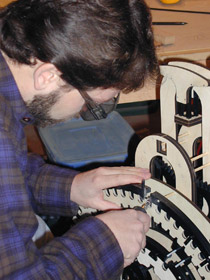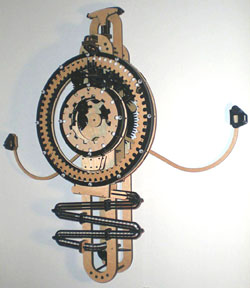 Cecil Vortex: I read that you also create mechanical art. What’s that work like?
Cecil Vortex: I read that you also create mechanical art. What’s that work like?
Adam Tobin: After I sold the first toy company, I had a few larger-scale projects I’d always wanted to pursue. The first thing I wanted to make was a clock that told time with rolling marbles. I’d wanted to make it since I was a kid. And I started making it and ended up making a few other contraption-type pieces. It was just such a joy for me, after years of designing things to be mass produced to say, “I’m just going to make one, and I’m not as concerned about how you can make 10,000 of these.” In essence, they were very large one-of-a-kind toys.
CV: Do you still work on those projects?
AT: I have a shop in the East Bay, and I still work on some of those concepts on the side. Though I have to say, for me, there was something about it that wasn’t completely fulfilling in that they were more solo endeavors. One of the reasons I got back in the toy business, and now I’m at the Exploratorium, is that I do very much enjoy different people’s perspectives.

Tobin’s rolling-marbles clock
CV: From what we talked about before, it sounds like having other people involved is as important to you as having a singular vision driving the project.
AT: A lot of the people I most respect, I look at and I think, “Wow, they had a dual gift,” like Jim Henson, for example. The Muppets were his singular vision, and yet, he was able to incorporate/allow/involve an entire ensemble into his vision. They had creativity coming from so many different places, and he was, in essence, orchestrating it. Not all of the great ideas were his. They didn’t have to be. And yet he somehow tied it all together. I really admire both of those skills and try to work on both in myself.
CV: Henson created The Muppets, but we assume Frank Oz created “Grover” — Grover wasn’t made by six people.
AT: Right. You know, I just saw the guy who played “The Great Gonzo” at a Muppet colloquium the other night, and watching what he was able to do as an individual creative within the Jim Henson construct was just — I mean, “Wow!”
He was showing old clips from The Muppets pilot and their promo trailer for [what had then been] the new Muppets show and Sesame Street. If you watch what they were doing, it was just so authentic. Even seeing him up there, watching the movies along with us and still laughing his ass off at what he’d done, you could just see him remembering not only how funny what they created was, but how much fun they’d had doing it.
[Authenticity means] that you created something that you, as the creator, think is cool. That seems to be a consistent ingredient to a great toy. You have marketing people say, ‘I think nine out of ten kids will like this,’ and that rarely is as neat as some crazy toy inventor that thinks, ‘This is the coolest thing ever’…
CV: Jumping back to the toy business, what do you think makes a great toy great?
AT: First off, it has to work within established play patterns. Kids are a certain way and they have certain inclinations and ways they like playing with things. There are things they like to learn and ways they like to be active. And by and large, great toys don’t try to get kids to do something that they’re not inclined to do.
A simple example would be role-play. Kids like role-play. They like to dress up as things, they like to pretend to be things. They have wonderful imagination. And so if you can create toys that work within that, augment it, enhance it, then you’ve got a good product.
Bio
Adam Tobin is the Director of Exhibit Development at San Francisco’s famed Exploratorium. Before that he was an entrepreneur and an award-winning toy inventor whose creations included Frigits, Getups, Tub Tunes Water Flutes and Drums, and SuperFort. His creations are sold around the world and have been featured in New York Magazine, Discover Magazine, CBS Morning News, Fox News, CNN, Regis and Kelly Ripa,and the New York Times.
A great example of that might be a yo-yo. A yo-yo goes up and down, up and down. Most people can get it fairly quickly. But then, should you want to keep going, you’ll have masters at the yo-yo doing things that you could never conceive.
The third is, really, authenticity. That means — and this is true for a lot of creativity — that you created something that you, as the creator, think is cool. That seems to be a consistent ingredient to a great toy. You have marketing people say, “I think nine out of ten kids will like this,” and that rarely is as neat as some crazy toy inventor that thinks, “This is the coolest thing ever,” and other people think so, too.
CV: What’s the best advice you’ve gotten over the years, or the advice you’d offer from your own experience, about the creative process?
AT: You have to allow it to be what it is; that’s the first thing. You have to work within your own natural flow. You just can’t change it dramatically. You can learn, and you should strive to learn, to maximize the upside of your tendencies and minimize the downside.
When I talk, for example, about myself being obsessive, the fact that I’m obsessive cuts both ways. If I try to say, “I’m going to be balanced in my creative approach,” I’m just going to be creating inner turmoil. At the same time, I can’t let it completely consume me. So, you know, people have to go with their own natural rhythm, but they have to recognize the parts of that that are productive and constructive and try to compartmentalize or minimize the parts that aren’t. And given time, that can be done.
But you can’t make someone who’s a slow burn into an obsessive, or vice versa. Whatever wiring inside you allows you or compels you to be creative, a lot of that wiring ain’t gonna change over the years.
e.
February 1, 2009 at 7:45 pm
thanks for this interview. i particularly like the analysis of what makes a great toy. and thanks, mr. vortex, for the photograph of the clock–a nice surprise.
carol
February 9, 2009 at 4:45 am
Its always great to hear an interview with an inventor such as yourself.